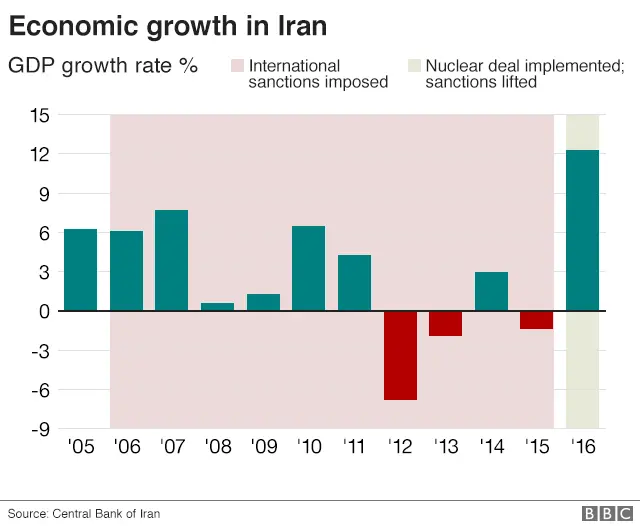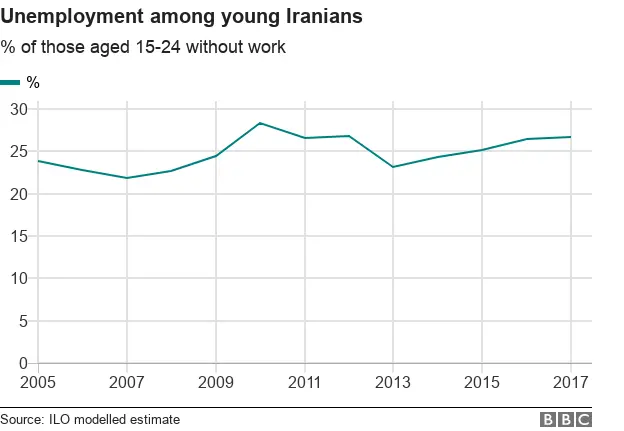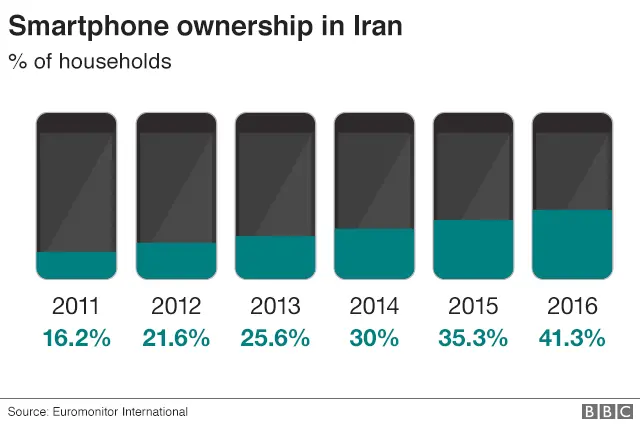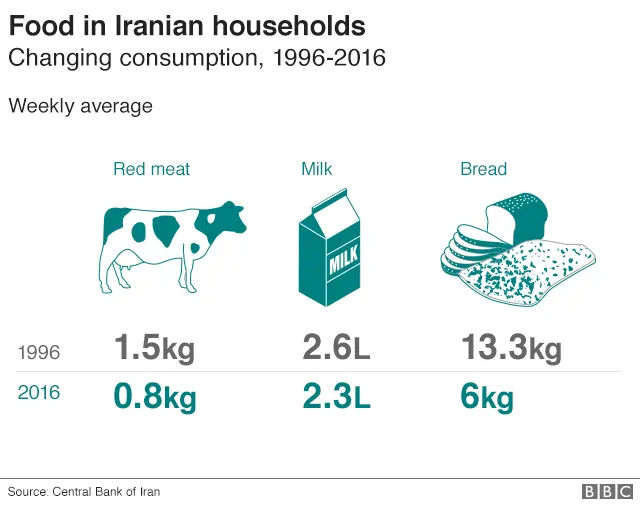Six charts that explain the Iran protests
The biggest anti-government protests in Iran for nearly a decade have been fuelled by rising discontent, in particular over the cost of living.
Here are six charts that help explain the hardships faced by ordinary Iranians.
1. Economic growth has been constrained by sanctions
Iran's economy was badly affected for several years by sanctions imposed by the international community over the country's nuclear programme.

Gross domestic product (GDP) contracted 1.4% in 2015 - the year President Hassan Rouhani, a moderate, agreed with world powers to limit Iran's sensitive nuclear activities.
In 2016, after the deal was implemented and most sanctions were lifted, the economy bounced back sharply and GDP grew 12.3%, according to the Central Bank of Iran. Much of that growth was attributed to the oil and gas industry.
Last month, the International Monetary Fund (IMF) said growth had begun to spread to the non-oil sector, and predicted that GDP would expand by 4.2% in the 2017/18 fiscal year.
The recovery has nevertheless not been as significant as many Iranians hoped.
Analysts point to the fact that US sanctions on financial transactions with Iran have remained in place, which has deterred foreign companies from doing business there. And in October, US President Donald Trump refused to recertify the nuclear deal and called on Congress to consider restoring sanctions.
2. Inflation is high
Inflation has fluctuated greatly in Iran since the Islamic revolution in 1979.

In 2013, the rate hit 31% as the economic sanctions reduced Iran's oil revenue and led to its currency, the rial, being devalued by more than 450%.
Inflation has steadily decreased under Mr Rouhani. In 2016 it was 11%, according to the Central Bank of Iran. The World Bank expects inflation to remain below 12% over the next three years.
Mr Rouhani has proposed a budget for the fiscal year starting in March 2018 that would see expenditure rise about 6% to $104bn. However, that would represent a cut in real terms at the current inflation rate.
3. Young people are struggling to find jobs
The official unemployment rate is 12.4%, but in some parts of the country it is more than 60%, according to Interior Minister Abdolreza Rahmani-Fazli.

Young people - more than half of the population of 79.9 million is under 30 - are among the worst affected. The International Labour Organization (ILO) estimates that 26.7% of 15-24 year olds are unemployed. Underemployment is also high - 12.4% - among 15-24 year olds, according to the ILO.
The IMF has warned that despite the high economic growth rate, not enough jobs are being created to absorb the large number of people entering the labour market. Analysts say that is because most of the recovery can be attributed to the oil industry, which is not labour-intensive.
4. Smartphone ownership in Iran is increasing
Smartphones have played an important role in the current protests.

People used the messaging app Telegram, which has millions of users in Iran, to organise protests and share videos and photographs taken with their phone cameras. When Telegram refused to suspend popular channels, the Iranian authorities blocked access to the app.
In 2009, when millions of people took to the streets of Tehran to demand the re-run of a disputed presidential election, there were some 55m mobile subscriptions in Iran. However, only about 2% are believed to have been for smartphones.
Today, there are more than 80m mobile subscriptions and 41% of households are estimated to have access to at least one smartphone.
5. People are becoming poorer
A recent investigation by BBC Persian found that on average, Iranians have become 15% poorer in real terms over the past decade.

The World Bank says that poverty in Iran fell between 2009 and 2013 to about 8%, although it increased to 10.5% in 2014 - President Rouhani's first year in office.
It estimates that 8.2 million people were living on less than $5.50 per day in 2014. About 2%, or 196,000 people, were living on less than $1.90.
Low-income families are dependent on a monthly cash transfer from the government worth about $13 that some 77 million Iranians receive. Mr Rouhani's draft budget would cut the payments by $5.3bn in total, which would reportedly affect 30 million people on higher incomes.
He also proposed raising the price of petrol by 50%, from $0.30 per litre to $0.45.
6. People can't afford to buy as much food
The consumption of bread, milk and red meat in Iranian households had decreased by between 30% and 50% over the past 10 years, according to BBC Persian.

With Iranians becoming poorer in real terms and the prices of many basic foodstuffs increasing by about 40% in the past year, many people simply cannot afford to buy as much food.
A 50% rise in the price of eggs - the result of a nationwide hen shortage caused by an outbreak of bird flu - was reportedly a trigger for the protest in Mashhad, the first in the latest unrest which quickly spread across the country.
BBC Persian service's Behrang Tajdin contributed to this story.
